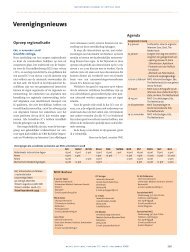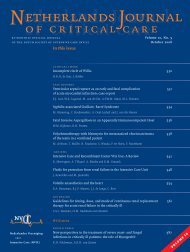Netherlands Journal of Critical Care
Netherlands Journal of Critical Care - NJCC
Netherlands Journal of Critical Care - NJCC
Create successful ePaper yourself
Turn your PDF publications into a flip-book with our unique Google optimized e-Paper software.
<strong>Netherlands</strong> <strong>Journal</strong> <strong>of</strong> <strong>Critical</strong> <strong>Care</strong><br />
Accepted January 2013<br />
CASE REPORT<br />
A rare cause <strong>of</strong> cardiac failure following<br />
transthoracic oesophagectomy<br />
D.A. Wicherts 1 , S. Hendriks 2 , W.L.E.M. Hesp 1 , J.A.B. van der Hoeven 1 , H.H. Ponssen 2<br />
1<br />
Albert Schweitzer Hospital, Department <strong>of</strong> Surgery, Dordrecht, The <strong>Netherlands</strong><br />
2<br />
Albert Schweitzer Hospital, Department <strong>of</strong> Intensive <strong>Care</strong> Medicine, Dordrecht, The <strong>Netherlands</strong><br />
Correspondence<br />
D.A. Wicherts – e-mail: d.a.wicherts@asz.nl<br />
Keywords - Oesophagectomy, cardiac failure, chylomediastinum, chylothorax<br />
Abstract<br />
Following elective transthoracic oesophagectomy in a 75-year old<br />
female, sudden haemodynamic instability occurred on the second<br />
postoperative day, requiring re-intubation and inotropic support. A<br />
large mediastinal fluid collection with mechanical compression <strong>of</strong> the<br />
heart was found with computed tomography imaging <strong>of</strong> the thorax.<br />
Restoration <strong>of</strong> cardiac function was noted following successful surgical<br />
fluid drainage. Subsequent ligation <strong>of</strong> the thoracic duct because <strong>of</strong><br />
persisting leakage <strong>of</strong> chylous fluid resulted in final patient recovery.<br />
Chyle leakage following oesophagogastrectomy usually results in pleural<br />
effusion. However, a chylomediastinum may sometimes occur with<br />
potentially significant haemodynamic consequences. Recognition <strong>of</strong> the<br />
thoracic duct at initial surgery with or without prophylactic ligation is<br />
crucial for preventing major complications caused by chyle leakage.<br />
Introduction<br />
During oesophagogastrectomy, injury to the main thoracic duct or<br />
its branches <strong>of</strong>ten occurs. This is related to the close anatomical<br />
proximity <strong>of</strong> the thoracic duct to the oesophagus. As a consequence,<br />
lymphatic fluid may leak into the thoracic cavity, resulting in<br />
a so-called chylothorax 1 . This complication causes significant<br />
morbidity, but fortunately is relatively uncommon. The overall<br />
incidence is reported to be around 2% to 3%, depending on the type<br />
<strong>of</strong> surgical approach used 2 . Opening the thoracic cavity during a<br />
transthoracic approach logically increases the risk <strong>of</strong> a chylothorax<br />
compared to a transhiatal oesophagogastrectomy.<br />
A chylothorax usually presents as a high-volume lymphatic output<br />
from a chest tube or an undrained pleural effusion on a chest<br />
radiograph. A chylomediastinum (mediastinal chyle collection),<br />
however, may have significant haemodynamic consequences due to<br />
its close relationship with the heart and major vascular structures.<br />
This situation is illustrated in the following case report.<br />
Case report<br />
A 75-year old female was admitted to our hospital with a<br />
biopsy-proven squamous cell carcinoma <strong>of</strong> the distal oesophagus.<br />
At preoperative work-up, including endoscopic ultrasound as well<br />
as computed tomography (CT) imaging <strong>of</strong> the thorax and abdomen,<br />
it was classified as a cT 3<br />
N 1<br />
tumour. Following standard preoperative<br />
chemoradiotherapy, a transthoracic oesophagectomy was performed<br />
with a primary anastomosis located in the neck.<br />
During surgery, the oesophagus and surrounding lymph nodes were<br />
mobilized through a right thoracotomy and incisions in the upper<br />
abdomen and neck. The anastomosis was made between the cervical<br />
oesophagus and the fundus <strong>of</strong> the stomach. The initial surgery was<br />
uneventful. Drains were situated in the neck, right pleural cavity<br />
and upper abdomen. Postoperatively, the patient was admitted to<br />
the Intensive <strong>Care</strong> Unit and was extubated the following day without<br />
any problems.<br />
On postoperative day (POD) 2, the patient suddenly deteriorated<br />
haemodynamically (hypotension, tachycardia and increased central<br />
venous pressure [23 mm Hg]), requiring re-intubation and inotropic<br />
support. The chest radiograph showed bilateral pleural effusions<br />
for which an additional chest tube was placed at the left side,<br />
draining a large amount <strong>of</strong> typical chylous (milky) fluid. Laboratory<br />
analysis showed an elevated level <strong>of</strong> triglycerides (5.3 mmol/L)<br />
suggestive for chyle. Fluid cultures were negative. Additionally,<br />
conservative treatment with total parenteral nutrition (TPN) was<br />
started. However, the patient did not improve. Subsequent CT<br />
imaging <strong>of</strong> the thorax showed a large mediastinal fluid collection<br />
adjacent to the neo-oesophagus, compressing the left atrium <strong>of</strong><br />
the heart ( figure 1). Additional cardiac ultrasound confirmed low<br />
cardiac output due to external compression <strong>of</strong> the left atrium with<br />
a subsequent decrease <strong>of</strong> cardiac inflow. At re-laparotomy on POD<br />
3, the mediastinal collection was drained through a transhiatal<br />
approach using the upper abdominal incision. Immediate reduction<br />
in the patient’s need <strong>of</strong> vasopressors and inotropic support<br />
was noted as well as a marked decrease in heart rate following<br />
successful drainage. Central venous pressure decreased to 11 mm<br />
Hg. Postoperative cardiac ultrasound confirmed the presence <strong>of</strong> a<br />
normalized cardiac function. A medium-chain triglyceride (MCT)<br />
diet was started postoperatively.<br />
30 Neth j crit care – volume 17 – no 1 – february 2013







